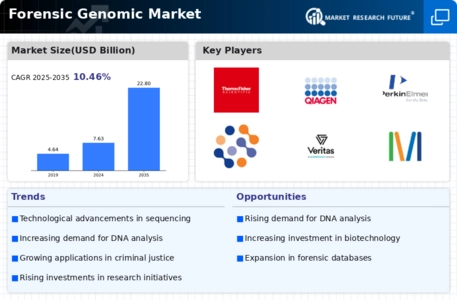Rising Crime Rates
The Forensic Genomic Market is experiencing growth due to the rising crime rates observed in various regions. As law enforcement agencies face increasing challenges in solving crimes, the demand for advanced forensic genomic technologies has surged. This trend is particularly evident in urban areas where violent crimes and property offenses have escalated. The integration of genomic analysis in criminal investigations enhances the accuracy of evidence collection and analysis, thereby improving case resolution rates. According to recent statistics, the use of genomic techniques in forensic science has led to a significant increase in successful identifications of suspects, which in turn drives the demand for innovative solutions within the Forensic Genomic Market. Consequently, stakeholders are investing in research and development to create more efficient and reliable genomic tools for crime scene investigations.
Regulatory Frameworks
The establishment of robust regulatory frameworks is a crucial driver for the Forensic Genomic Market. Governments and regulatory bodies are increasingly recognizing the need for standardized practices in forensic genomics to ensure the reliability and validity of genetic evidence. These frameworks provide guidelines for the ethical use of genomic data, thereby fostering public trust in forensic technologies. As regulations evolve, they are likely to encourage investment in research and development, as companies seek to comply with new standards. Furthermore, the harmonization of regulations across jurisdictions can facilitate international collaboration in forensic investigations, enhancing the overall effectiveness of the Forensic Genomic Market. Recent legislative initiatives aimed at improving forensic practices are expected to stimulate market growth, as they create a conducive environment for innovation and technological advancement.
Technological Innovations
Technological innovations play a pivotal role in shaping the Forensic Genomic Market. The advent of next-generation sequencing (NGS) and advanced bioinformatics tools has revolutionized the way forensic evidence is analyzed. These technologies enable rapid and accurate genomic profiling, which is crucial for solving complex cases. The market is witnessing a shift towards automation and high-throughput screening methods, which enhance the efficiency of forensic laboratories. As a result, the demand for sophisticated genomic analysis tools is on the rise. Recent market analyses indicate that the adoption of these technologies is expected to grow at a compound annual growth rate (CAGR) of over 10% in the coming years. This growth is driven by the need for faster turnaround times in forensic investigations, thereby propelling the Forensic Genomic Market forward.
Growing Demand for Personalized Justice
The Forensic Genomic Market is witnessing a growing demand for personalized justice, as stakeholders seek to ensure that forensic evidence is tailored to individual cases. This trend is driven by the recognition that each case presents unique challenges that require specific genomic solutions. Law enforcement agencies are increasingly adopting personalized approaches to forensic investigations, utilizing genomic data to provide more accurate and relevant evidence. This shift is likely to enhance the effectiveness of criminal justice systems, as it allows for more precise identifications and case resolutions. Market projections indicate that the demand for personalized forensic genomic solutions will continue to rise, as stakeholders prioritize accuracy and reliability in their investigative processes. Consequently, the Forensic Genomic Market is poised for growth as it adapts to meet the evolving needs of the justice system.
Increased Awareness of Genetic Evidence
There is a growing awareness of the importance of genetic evidence in criminal investigations, which significantly impacts the Forensic Genomic Market. As public understanding of DNA's role in solving crimes expands, law enforcement agencies are increasingly incorporating genomic analysis into their investigative processes. This trend is further supported by high-profile cases that have highlighted the effectiveness of DNA evidence in securing convictions. The demand for training and education in forensic genomics is also rising, as professionals seek to enhance their skills in this evolving field. Market data suggests that educational programs focusing on forensic genomics are experiencing increased enrollment, reflecting the heightened interest in this area. Consequently, the Forensic Genomic Market is likely to benefit from this increased emphasis on genetic evidence, leading to further advancements and innovations.


















Leave a Comment